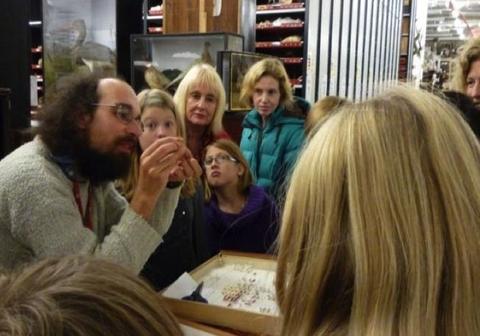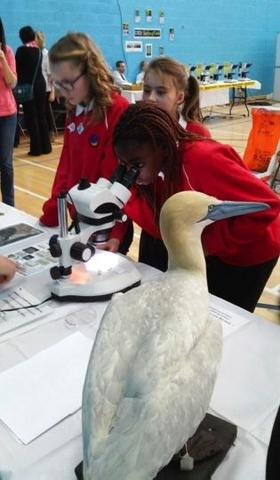A blog from a curatorial perspective illustrating how and why education and curatorial staff work together to use natural science collections at Leeds Museums and Galleries

In the store at Leeds Museum Discovery Centre ©Leeds Museums and Galleries
Why wouldn’t you allow your education team to use your natural science objects? In some museums, education staff work with separate collections designated for use in workshops, and do not have access to wider collections. Here at Leeds Museums and Galleries (LMG), we have no separate education or handling collection. Objects from our collection can be used for education sessions, public workshops and display as well as research. While this can present challenges, this single-collection approach makes for a truly connected museum. It seems extraordinary that a museum would separate the public from its core collections.
A museum is not a museum without objects, and using real ones with the public genuinely enhances your audience’s experience and sense of joy and wonder. Real objects create reverence, excitement, even pride and are a pleasure to work with. It’s great to reply “yes” to the popular “is it real?” question as it leads on to so many conversations. Natural science in particular has the ability to grab people’s attention immediately. An education colleague once told me that whilst she dealt with a good deal of museum disciplines, “natural history is my easiest, safest, most accessible, most inspiring [collection].” A good education officer will use real objects to make a visitor feel they are getting to do, see or perhaps touch something that very few other people get the chance to.
Whose collection is it anyway?
Looking at, working with, handling and sometimes touching real objects empowers visitors. The trust we as museum staff put in visitors to interact with objects from our collections can also be of significant importance to an individual. LMG is a local authority owned and supported museum service. The collection was established for the people of Leeds and is in effect owned by them. We as curators and education staff serve this public, and part of our role is enabling access to this collection, not building a fortress around it. Keeping this at the forefront of curatorial thinking helps LMG consider the relationship between visitors and objects constantly.
Risk assessment
What needs to be considered when curating collections for the public to use? The risk of damage to objects may seem scary: brittle little antennae; the most delicate of crystal forms; a couldn’t-care-less schoolgirl; toddler spittle or teenager snot. Similarly, the risk to people themselves may appear equally terrifying: taxidermy containing arsenic; rusty industrial bits to snag little fingers on; curare tipped arrows or discovering an object may actually be radioactive. In reality, a number of measures can be used to minimise potential problems, such as training, good standards of documentation and clear communication with visitors. With proper risk analysis, dialogue between curatorial and education staff and thoughtful choice of appropriate objects, risks can be minimised. Minimal risks can also be weighed up against the beneficial outcomes of using objects, such as the learning outcomes and pleasure gained by the public. It should also be remembered that the decision to not use an object is not without risk. A collection that is not being used effectively may be exposed to risks such as not being valued by external funders or stakeholders, missed opportunities to educate and inspire, as well as potentially being more vulnerable to pests, if pest activity goes unnoticed.

Real and really small. ©Leeds Museums and Galleries
Dialogue
The curators at LMG regularly run ‘how to use the collections’ workshops for all museum staff including education, marketing, visitor assistants or commercial staff. Shift workers are given extra hours to enable them to attend, and new starters and volunteers are encouraged to come to the sessions, which run regularly. I think it’s important that curators and conservators are involved, sharing our knowledge and expertise on how to care for the objects in the collection, and why they should be used.
Good collection care boils down to communication. Asking non-curatorial staff to care for objects and pass on that respect to visitors requires good understanding of the issues involved, common goals and plenty of negotiation, education and dialogue.
A previous education officer at LMG once watched an external workshop in which lots of new, high quality, fake plastic skulls were used. They had been drawn on and damaged by the end of the first forty-minute session. There was no care implied and no talk about the reasons museums are careful with things. At LMG, we use real objects for education sessions, but also explain the reasons for careful handling and any necessary limits to how an object can be used. We are careful but still fully engage our public. We explain that the museum objects belong to the public, but also future generations. This line of reasoning has no meaning if someone is handling a fake or something bought from the internet for a workshop.
The limits
Curatorial staff can and do say no. Careful weighing of risks and outcomes mean that every case is considered on its own merits.
If you are thinking on how to start using natural science collections for handling, here are some of my top tips:
- Consider your audience: Who will be using the objects, e.g. children or adults, schools or families? What would you like to use the objects for, e.g. a schools workshop, public event or exhibition? What would you like the outcomes of the activity to be, e.g. learning, inspiration or conservation action?
- Consider your collection: Which objects would be ideal for your activity? What risks would they be exposed to? What risks could they pose to the users? What would be the risks of not using them?
- Talk to your colleagues: Curators, educators and conservators may all have different perspectives on how objects should be used and handled. All types of staff have expertise in their own fields, and their own roles to play in deciding how and in which contexts to use objects. With proper dialogue and mutual respect, solutions can be found which make good use of collections, and benefit the public.
- Offer mutual support and training: Curators can advise education staff on how to handle objects appropriately, and pass on stories about objects or information about different species and concepts. In turn, education staff can show curators how objects can be used to inspire the public, and how to make objects resonate with visitors.
- Trust: As curators, it is not our job to lock up collections and throw away the key. We have objects in museums for people to use and enjoy, perhaps now, perhaps in the future. By working closely with colleagues and trusting their expertise and experience, we can facilitate the use of collections to benefit our visitors, as well as the biodiversity we share our planet with. We also need to trust the public. Most people are capable of understanding and respecting the reasons behind putting boundaries on how and why objects are handled, so long as they are properly explained.

LMG objects being used at a University of Leeds schools event. ©Leeds Museums and Galleries
If you would like to know more about handling collections do drop me a line at: clare.brown@leeds.gov.uk and you can join the Subject Specialist Network NatSCA Jiscmail list to ask colleagues throughout the UK too.
By Clare Brown, Curator of Natural Science, Leeds Museums and Galleries
Add new comment